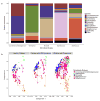The Nasopharyngeal Microbiota of Children With Respiratory Infections in Botswana
- PMID: 28399056
- PMCID: PMC5555803
- DOI: 10.1097/INF.0000000000001607
The Nasopharyngeal Microbiota of Children With Respiratory Infections in Botswana
Abstract
Background: Nearly half of child pneumonia deaths occur in sub-Saharan Africa. Microbial communities in the nasopharynx are a reservoir for pneumonia pathogens and remain poorly described in African children.
Methods: Nasopharyngeal swabs were collected from children with pneumonia (N = 204), children with upper respiratory infection symptoms (N = 55) and healthy children (N = 60) in Botswana between April 2012 and April 2014. We sequenced the V3 region of the bacterial 16S ribosomal RNA gene and used partitioning around medoids to cluster samples into microbiota biotypes. We then used multivariable logistic regression to examine whether microbiota biotypes were associated with pneumonia and upper respiratory infection symptoms.
Results: Mean ages of children with pneumonia, children with upper respiratory infection symptoms and healthy children were 8.2, 11.4 and 8.0 months, respectively. Clustering of nasopharyngeal microbiota identified 5 distinct biotypes: Corynebacterium/Dolosigranulum-dominant (23%), Haemophilus-dominant (11%), Moraxella-dominant (24%), Staphylococcus-dominant (13%) and Streptococcus-dominant (28%). The Haemophilus-dominant [odds ratio (OR): 13.55; 95% confidence interval (CI): 2.10-87.26], the Staphylococcus-dominant (OR: 8.27; 95% CI: 2.13-32.14) and the Streptococcus-dominant (OR: 39.97; 95% CI: 6.63-241.00) biotypes were associated with pneumonia. The Moraxella-dominant (OR: 3.71; 95% CI: 1.09-12.64) and Streptococcus-dominant (OR: 12.26; 95% CI: 1.81-83.06) biotypes were associated with upper respiratory infection symptoms. In children with pneumonia, HIV infection was associated with a lower relative abundance of Dolosigranulum (P = 0.03).
Conclusions: Pneumonia and upper respiratory infection symptoms are associated with distinct nasopharyngeal microbiota biotypes in African children. A lower abundance of the commensal genus Dolosigranulum may contribute to the higher pneumonia risk of HIV-infected children.
Conflict of interest statement
Figures



References
-
- United Nations Children’s Fund. [Accessed January 21, 2017];One is Too Many: Ending Child Deaths from Pneumonia and Diarrhoea. Available at: https://data.unicef.org/resources/one-many-ending-child-deaths-pneumonia...
-
- United Nations Children’s Fund. Pneumonia and diarrhea: tackling the deadliest diseases for the world’s poorest children. New York: UNICEF; 2013. - PubMed
MeSH terms
Grants and funding
LinkOut - more resources
Full Text Sources
Other Literature Sources
Miscellaneous

